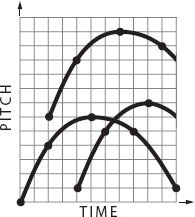Homophony and Polyphony

When there is only one melody of real interest and it is combined with other, less prominent sounds, the texture is called homophonic. A harmonized melody is an example of homophonic texture; for instance, one person singing the tune of “Yesterday” while playing chords on a guitar. We might indicate a chord on the pitch/time graph by a vertical box enclosing the dots (see margin). Each box represents a chord; the sum of these boxes represents the harmony. Homophony can be thought of as a tight, smooth texture — like silk, among textiles.
When two or more melodies are played or sung simultaneously, the texture is described as polyphonic. In polyphony (po-

It’s also important to recognize that polyphonic music automatically has harmony. For at every moment in time, on every beat, the multiple horizontal melodies create vertical chords; those chords make harmony. A word often used for polyphonic texture is contrapuntal, which comes from the word counterpoint, the technique of writing two or more melodies that fit together.